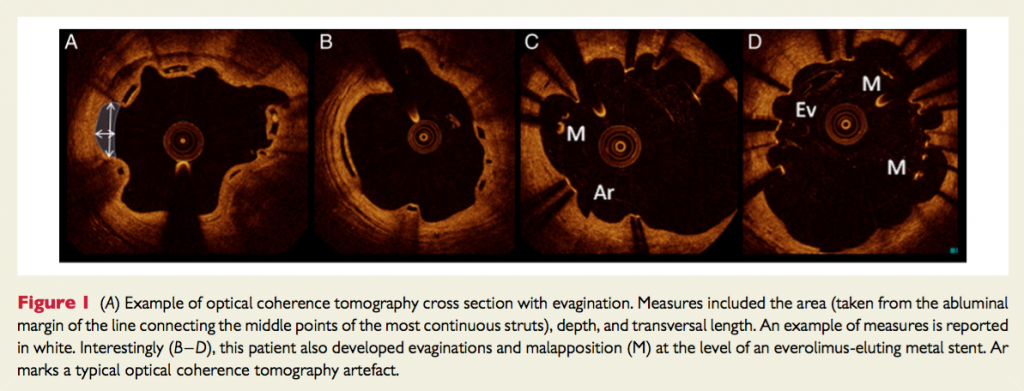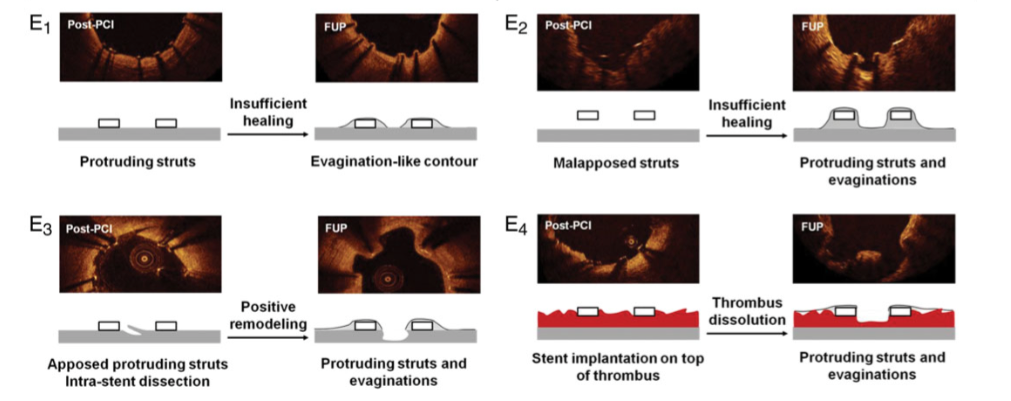BVSでEvaginationが多いって本当?
Coronary evaginations and peri-scaffold aneurysms following implantation of bioresorbable scaffolds: incidence, outcome, and optical coherence tomography analysis of possible mechanisms
Gori T, Jansen T, Weissner M, Foin N, Wenzel P, Schulz E, Cook S, Münzel T.
Eur Heart J. 2015 Nov 4. pii: ehv581. [Epub ahead of print]
Absorb BVS植え込み後の、90症例102 BVS (年齢63±13歳, 男性71人, 糖尿病14人)を対象に治療12ヶ月後のOCTとAngioで”Evagination”を評価しています。(1) 結果、54%のBVSで少なくとも1つのEvaginationが認められました(6.1±6.2 Evaginations/BVS)。またEvaginationはMalappositionとStrut fractureに強く関連していたとのことです。PSSは18%で認められ、この値はSESの2%と比較しても非常に高くなります。(2) 結論として、最近のDESと比較してEvaginationはBVSに比較的よく見られるとされています。

しかし、これは非常に危険な見解だと思われます。
DES植え込み後のcoronary artery ectasiaやaneurysms、そしてEvagination、AngioではPSS (peri-stent contrast staining)として認識され、ステント血栓症との関連から注目されていますが、(3)この現象の発生機序は血管のPositive remodelingと考えられています。そして、DES植え込み後の炎症反応が、このPositive remodelingの誘因となり、ZESやEESに比べてSESで多く認められました。SESで顕著に認められた外膜の炎症と繊維化がこのPositive remodelingに関わると考えられています。(4,5)
この認識で、この論文を読むと大きな誤解を生む可能性があります。この論文の大きな問題点はベースラインのOCT画像なしにフォローの画像のみでEvaginationを語っているところです。
Radu et alのオリジナルの論文では次のようにEvaginationを定義しています。(6)
“Evaginations were defined as bulges in the luminal contour between struts with a maximum depth (white double-headed arrow) exceeding the actual strut thickness.”
そして、植え込み直後とフォローアップのOCT画像をマッチさせて比較し、その原因はPositive remodelingであると明確に述べています。
“The association between positive remodelling and major evagination suggests that positive remodelling is the mechanism underlying the pathogenesis of evaginations.”
確かに、上記の定義のみでフォローアップのOCT画像だけを見ますと、今回のGori et al.のようなデータになるかもしれませんが、コンセプトが全く違ってきてしまいます。もともとのコンセプトのEvaginationはベースラインとフォローアップを比較して初めて評価できるもので、フォローアップのみでは何も言えません。フォローの画像のみではEvaginationと、MalappositionにBackside connecting bridgeができた状態(7)が区別できません。
言い換えますと、炎症反応によりPositive remodelingが起こってEvaginationができているのか(異常反応)、単にNeointimal coverageのひとつの過程で、Backside connecting bridgeができているのか(正常反応)が全く区別できません。後者の場合、さらにフォローアップ期間を延ばせばEvaginationは全て消えている可能性が十分にあります。そのため、ベースラインのOCT画像がなければ何も語れないはずです。Editorialの中でも、この点については明確に指摘していませんが、メカニズムを説明するFigureで、後者のメカニズムを示した画像の中でEvagination-likeと表現しています (Figure E2)。(8)

もう一つの点はBVSの症例でPSSを評価していますが、そもそも透視に映らないPolymeric ScaffoldのPSSをどうやって判断しているのか疑問ですし、論文中における定義も曖昧です。
あまり否定的なことばかり書きたくありませんが、こういった観点で論文の結果をしっかり見ますと、かなり見解が変わってきます。このStudy populationのさらに1年、2年後のOCTデータが非常に興味深いところです。
References
1. Gori T, Jansen T, Weissner M et al. Coronary evaginations and peri-scaffold aneurysms following implantation of bioresorbable scaffolds: incidence, outcome, and optical coherence tomography analysis of possible mechanisms. European heart journal 2015.
2. Palmerini T, Benedetto U, Biondi-Zoccai G et al. Long-Term Safety of Drug-Eluting and Bare-Metal Stents: Evidence From a Comprehensive Network Meta-Analysis. Journal of the American College of Cardiology 2015;65:2496-507.
3. Imai M, Kadota K, Goto T et al. Incidence, risk factors, and clinical sequelae of angiographic peri-stent contrast staining after sirolimus-eluting stent implantation. Circulation 2011;123:2382-91.
4. Nakazawa G, Finn AV, Vorpahl M, Ladich ER, Kolodgie FD, Virmani R. Coronary responses and differential mechanisms of late stent thrombosis attributed to first-generation sirolimus- and paclitaxel-eluting stents. Journal of the American College of Cardiology 2011;57:390-8.
5. Roitstein A, Cheinberg BV, Kedem J, Tse J, Weiss HR, Scholz PM. Reduced effect of phenylephrine on regional myocardial function and O2 consumption in experimental LVH. The American journal of physiology 1995;268:H1202-7.
6. Radu MD, Raber L, Kalesan B et al. Coronary evaginations are associated with positive vessel remodelling and are nearly absent following implantation of newer-generation drug-eluting stents: an optical coherence tomography and intravascular ultrasound study. European heart journal 2014;35:795-807.
7. Nakatani S, Sotomi Y, Ishibashi Y et al. Comparative analysis method of permanent metallic stents (XIENCE) and bioresorbable poly-L-lactic (PLLA) scaffolds (Absorb) on optical coherence tomography at baseline and follow-up. EuroIntervention : journal of EuroPCR in collaboration with the Working Group on Interventional Cardiology of the European Society of Cardiology 2015;11.
8.Radu MD, Engstrom T. Casting light on coronary evaginations: different mechanisms in different coronary devices? European heart journal 2015.
